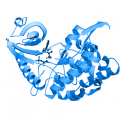
- Remove this product from my favorite's list.
- Add this product to my list of favorites.
Products
Viewed products
Newsletter
 |  |  |  |  |  |

CLK1 is a member of the CDC2-like (or LAMMER) family of dual specificity protein kinases. The protein phosphorylates serine/arginine-rich proteins (SR proteins) and tyrosine-containing substrates involved in pre-mRNA processing and of the spliceosomal complex. CLK1 may be a constituent of a network of regulatory mechanisms that enable SR proteins to control RNA splicing.
human CLK1 (CDC-like kinase 1), amino acids M1-I484 (as in NCBI/Protein entry NP_004062.2), recombinant and active (basal level) enzyme, N-terminally fused to GST-HIS6-Thrombin cleavage site, expressed in Sf9 insect cells
Theoretical MW: 86.7 kDa (fusion protein)
Expression system: Baculovirus infected Sf9 cells
Storage buffer: 50 mM Tris-HCl, pH 8.0;100 mM NaCl, 5 mM DTT, 4 mM reduced glutathione, 20% glycerol
Protein concentration: 0.139 mg/ml (Bradford method using BSA as standard protein)
Method for determination of Km value & specific activity: Filter binding assay MSPH membrane
Specific activity: 400 pmol/mg x min
Entrez Gene ID: 1195
UniProtKB: P49759
Ordering information: shipped on dry ice
Moeslein F.M., Myers M.P., Landreth G.E. (1999) "The CLK family kinases, CLK1 and CLK2, phosphorylate and activate the tyrosine phosphatase, PTP-1B." J. Biol. Chem. 274:26697-26704
Eisenreich A., Bogdanov V.Y., Zakrzewicz A., Pries A., Antoniak S., Poller W., Schultheiss H.P., Rauch U. (2009) "Cdc2-like kinases and DNA topoisomerase I regulate alternative splicing of tissue factor in human endothelial cells." Circ. Res. 104:589-599
Follow us